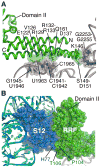Structures of the bacterial ribosome in classical and hybrid states of tRNA binding
- PMID: 21596992
- PMCID: PMC3176341
- DOI: 10.1126/science.1202692
Structures of the bacterial ribosome in classical and hybrid states of tRNA binding
Abstract
During protein synthesis, the ribosome controls the movement of tRNA and mRNA by means of large-scale structural rearrangements. We describe structures of the intact bacterial ribosome from Escherichia coli that reveal how the ribosome binds tRNA in two functionally distinct states, determined to a resolution of ~3.2 angstroms by means of x-ray crystallography. One state positions tRNA in the peptidyl-tRNA binding site. The second, a fully rotated state, is stabilized by ribosome recycling factor and binds tRNA in a highly bent conformation in a hybrid peptidyl/exit site. The structures help to explain how the ratchet-like motion of the two ribosomal subunits contributes to the mechanisms of translocation, termination, and ribosome recycling.
Figures




References
Publication types
MeSH terms
Substances
Associated data
- Actions
- Actions
- Actions
- Actions
Grants and funding
- R01 GM065050/GM/NIGMS NIH HHS/United States
- GM07739/GM/NIGMS NIH HHS/United States
- RR-15301/RR/NCRR NIH HHS/United States
- P01 CA092584/CA/NCI NIH HHS/United States
- P01-GM63210/GM/NIGMS NIH HHS/United States
- R01 GM074127/GM/NIGMS NIH HHS/United States
- P01 GM063210/GM/NIGMS NIH HHS/United States
- T32 GM007739/GM/NIGMS NIH HHS/United States
- GM088674/GM/NIGMS NIH HHS/United States
- R01 GM079238/GM/NIGMS NIH HHS/United States
- GM079238/GM/NIGMS NIH HHS/United States
- R01 GM088674/GM/NIGMS NIH HHS/United States
- CA92584/CA/NCI NIH HHS/United States
- P41 RR015301/RR/NCRR NIH HHS/United States
- GM074127-04S1/GM/NIGMS NIH HHS/United States
- GM65050/GM/NIGMS NIH HHS/United States
LinkOut - more resources
Full Text Sources
Other Literature Sources
Molecular Biology Databases

